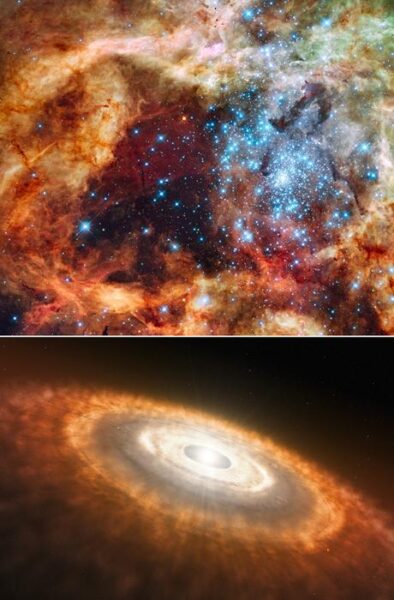In an impressive feat, a team of scientists and engineers have completed one of the largest and most ambitious Hubble Space Telescope programs ever undertaken. The three-year survey, called ULLYSES (Ultraviolet Legacy Library of Young Stars as Essential Standards), has collected data on nearly 500 stars, offering new insights into their formation, evolution, and impact on their surroundings.
The ULLYSES program, completed in December 2023, provides a rich spectroscopic dataset obtained in ultraviolet light that astronomers will be studying for decades to come. Because ultraviolet light can only be observed from space, Hubble is the only active telescope capable of conducting this research.
Julia Roman-Duval, Implementation Team Lead for ULLYSES at the Space Telescope Science Institute (STScI) in Baltimore, Maryland, believes that the ULLYSES project will be transformative, impacting various fields of astrophysics, from exoplanets to the effects of massive stars on galaxy evolution and understanding the earliest stages of the evolving universe. “Aside from the specific goals of the program, the stellar data can also be used in fields of astrophysics in ways we can’t yet imagine,” Roman-Duval said.
The ULLYSES team studied 220 stars and combined those observations with information from the Hubble archive on an additional 275 stars. The program also included data from some of the world’s largest and most powerful ground-based telescopes and X-ray space telescopes. The ULLYSES dataset consists of stellar spectra, which carry information about each star’s temperature, chemical composition, and rotation.
One type of star studied under ULLYSES is super-hot, massive, blue stars. These stars are a million times brighter than the Sun and glow fiercely in ultraviolet light that Hubble can easily detect. Their spectra include key diagnostics of the speed of their powerful winds, which drive galaxy evolution and seed galaxies with the elements needed for life. ULLYSES targeted blue stars in nearby galaxies that are deficient in elements heavier than helium and hydrogen, a type of galaxy common in the very early universe. “ULLYSES observations are a stepping stone to understanding those first stars and their winds in the universe, and how they impact the evolution of their young host galaxy,” Roman-Duval explained.
The other star category in the ULLYSES program is young stars less massive than our Sun. Though cooler and redder than our Sun, these stars unleash a torrent of high-energy radiation, including ultraviolet light and X-rays, during their formative years. The Hubble spectra include key diagnostics of the process by which they acquire their mass, including how much energy this process releases into the surrounding planet-forming disk and nearby environment. The blistering ultraviolet light from young stars affects the evolution of these disks as they form planets and the chances of habitability for newborn planets.
The ULLYSES concept was designed by a committee of experts to provide a legacy set of stellar observations using Hubble. Roman-Duval noted that the program was tremendously enhanced by community-led coordinated and ancillary observations with other ground- and space-based observatories, allowing astronomers to investigate the lives of stars in unprecedented detail and paint a more comprehensive picture of their properties and impact on their environment.
To celebrate the beginning of a new era of research on young stars, STScI hosted a ULLYSES workshop in March 2024, allowing members of the astronomical community to collaborate on the data, gain momentum in ongoing analyses, and kickstart new ideas for analysis. This workshop was an important step in exploiting this legacy spectral library to its fullest potential, fulfilling the promise of ULLYSES.
The Hubble Space Telescope, a project of international cooperation between NASA and ESA (European Space Agency), continues to make groundbreaking discoveries that shape our fundamental understanding of the universe after more than three decades of operation.


